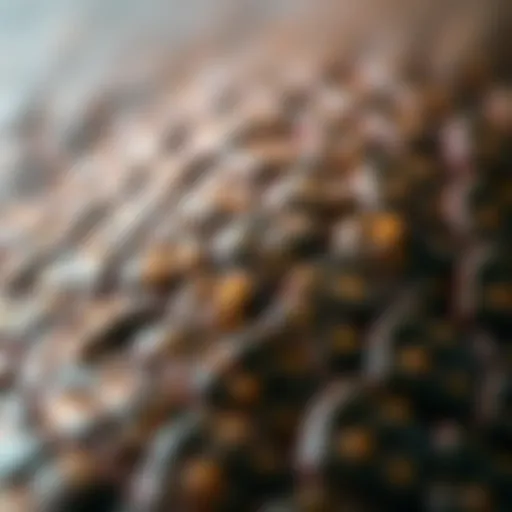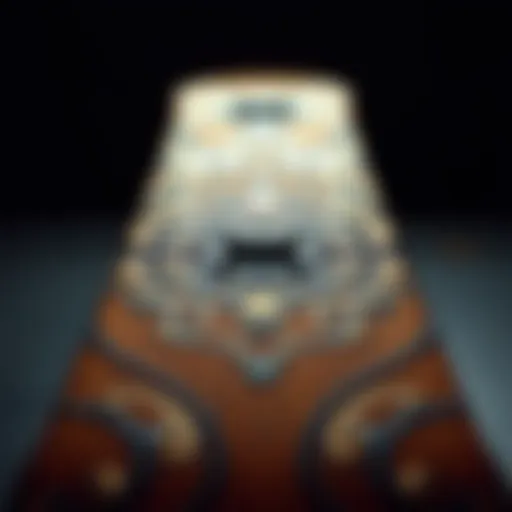Exploring the Jessup Grip: Insights for Skaters
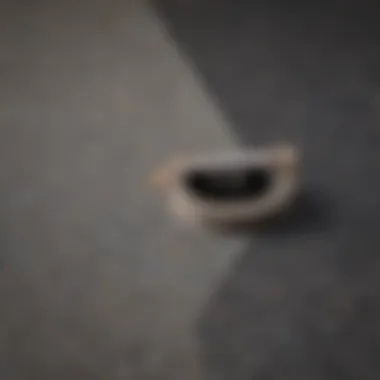

Intro
Skateboarding isn't just a sport; it's a way of life for many. A fundamental aspect of this lifestyle is the gear, and one of the most crucial elements is the grip tape that covers the skateboard deck. Among the myriad options available, Jessup grip tape has made a name for itself, known for its durability and performance. This article dives into the details of the Jessup grip, revealing its composition, effectiveness, and maintenance tips to snag the optimal performance from your setup.
Understanding grip tape isn't only for seasoned pros; it's essential for everyone from novices, just starting their journey, to experienced riders looking to refine their tricks. After all, a solid connection between your feet and the board can make or break your skating experience.
Let’s peel back the layers and get into it.
Gear Reviews
Skateboard Essentials: Decks, Trucks, and Wheels
Before delving into the specifics of Jessup grip, it's important to grasp how it fits into the broader context of skateboard equipment. Your skateboard comprises various components: the deck, trucks, and wheels. Each plays a vital role in your overall skating experience. Choosing the right components can influence how well the grip tape performs as well.
- Deck: The foundation of your ride. The width, length, and material can significantly affect balance and control. A wider deck pairs nicely with Jessup grip tape, offering extra space for foot placement.
- Trucks: Acting as the link between your wheels and the deck, trucks influence turning ability. If they’re set too loose or too tight, it might affect your grip when doing tricks.
- Wheels: Different wheel hardness and sizes dictate how your board rolls and interacts with surfaces. Softer wheels might grip the ground better on rough terrain, complementing the Jessup grip tape's texture.
Safety Gear: Helmets, Pads, and Protective Equipment
No article about skateboarding gear would be complete without mentioning safety. While Jessup grip tape helps keep you on your board, protective gear is your safety net. Helmets, knee pads, and elbow pads should always be part of your setup. It's all about balancing performance with safety. Wouldn’t hurt to remember: there’s no benefit to flashy tricks if you can’t even walk away from a fall.
Whether you're tackling an epic ramp or simply cruising down the street, the right gear combination is fundamental for both performance and safety.
Technique Guides
Fundamental Skills for Beginners: Stance and Balance
For skaters new to the scene, mastering your stance is key. A proper stance not only ensures comfort but also enhances balance, allowing you to develop essential skills. Ideally, your feet should sit shoulder-width apart on the grip tape for better stability. Consider which foot feels more comfortable at the back for balance. This is called your regular or goofy stance, and it’s crucial for every skater's journey.
Advanced Tricks: How to Master Board Slides and Ollies
Once you get your balance right, and you've spent some time riding, it’s time to tackle advanced tricks like board slides and ollies. Here’s where the Jessup grip tape shines, giving you the confidence to push boundaries.
- To achieve an ollie, you need to pop the tail of the board while dragging your back foot upward. The traction from the Jessup grip supports your foot, helping you maintain control during the leap.
- For board slides, positioning your body properly over the rail or ledge while balancing your weight is crucial. With the right grip, you’re less likely to slip off.
Prologue to Jessup Grip
When you step on a skateboard, the connection between you and the deck is undeniably vital, and that is where grip tape comes into play. In particular, Jessup grip tape has carved its niche as a benchmark in the skateboard community. This section delves into the significance of understanding Jessup grip, its characteristics, and how it can shape your skating experience.
The importance of selecting the right grip tape cannot be overstated. A skateboard deck without adequate grip tape can feel precarious, leading to a lack of confidence in performing tricks or navigating challenging terrain. Jessup grip tape, known for its high-quality construction and performance-driven design, stands out in a crowded market, providing skaters with a reliable source of traction.
Several elements warrant attention when considering Jessup grip. First, the texture of the tape enhances board feel, critical for executing tricks that require precision. Next, the durability of the tape contributes to a longer lifespan, often resulting in fewer replacements and more time spent riding. Lastly, familiarity with Jessup’s characteristics translates into greater control and an enhanced ability to tackle various skating styles.
In the upcoming sections, we will explore the specific features and historical context that define Jessup grip, ensuring a comprehensive understanding of why this grip tape remains a staple for beginners and seasoned skaters alike.
Defining the Jessup Grip
The Jessup grip is more than just a layer of textured material on a skateboard deck. It serves as the primary interface between the skater’s shoes and the board itself. Typically made from a blend of silicon carbide and backed with a robust adhesive, Jessup grip tape is famed for creating a solid bond with the skateboard surface, ensuring optimal performance.
It's important to note that the quality of grip tape can greatly influence a skater’s technique. The finer the grit, the more traction is available, allowing for finer foot placement and a firmer hold during maneuvers. This grip tape offers skaters confidence when attempting difficult tricks that might otherwise feel slippery and unsafe.
From street skating to vert, Jessup grip plays a significant role in a skater’s ability to execute moves that require precision. Its versatility not only supports various styles but also caters to individual preferences. In this way, skaters can tailor their setup for comfort and performance according to their unique needs.
Historical Context of Grip Tape in Skateboarding
To fully appreciate the importance of the Jessup grip, one must understand its lineage amidst the evolution of grip tape in skateboarding. In the late 1970s, as skateboarding gained popularity, so too did the need for better traction technology. Early grip tapes were often rudimentary, lacking in durability and performance.
Jessup grip tape made waves by introducing a more resilient construction and finer grit options. This innovation not only improved performance but also expanded the creativity of skaters. Over the decades, this grip tape became synonymous with the sport itself, adopted by many professional skateboarders who vouched for its reliability.
Today, Jessup is a major player in the grip tape market, standing alongside various other brands. Skaters recognize the significance of grip tape as both practical equipment and a matter of personal style. Customized designs have added a layer of personalization, further solidifying grip tape's role in the culture of skateboarding.
In summary, Jessup grip is not merely a functional asset; it carries a legacy that intertwines with the history and progression of skateboarding. Understanding its characteristics and historical development can help inform skaters of all levels when it comes to selecting the right grip tape for their riding style.
Materials and Composition
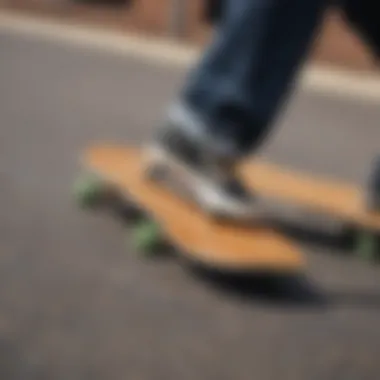

When discussing the functionality and performance of the Jessup grip tape, understanding its materials and composition is crucial. The grip tape isn’t merely a surface to stand on while performing tricks; it’s a synergy of design and materials that dictate a skater's performance on the board. The right combination of materials ensures optimal grip, durability, and aesthetic appeal, influencing everything from the feel during rides to how well a skater can execute complex maneuvers.
Types of Grip Tape Materials
Grip tapes vary widely in materials used, and each has distinct characteristics that can significantly affect performance. The two most prevalent types of materials used are traditional sandpaper-like grit tapes and newer foam-based alternatives.
- Grit Tape: The classic choice, grit grip tape is primarily made from a high-friction surface that improves traction considerably. The essential ingredient here is aluminum oxide, which enhances grip strength.
- Foam Tape: Emerging technologies have introduced softer, foam grip tape. This material promises additional comfort underfoot, which might be appealing for certain styles of skating, especially for longboarding.
Both types have their pros and cons. For those looking for superior grip and control, grit tape might be the go-to option. But foam grip tape could cater to skaters who prioritize comfort over sheer grip.
Foam vs. Paper Backing
Backing material serves as the unsung hero in grip tape construction. It must fulfill specific roles, such as providing durability and ease of application. Generally, grip tape can come with foam backing or paper backing, and their differences are notable.
- Foam Backing: Grip tape with foam backing tends to be more flexible, allowing for more dynamic application on irregular board shapes. Its cushioning may provide a soft touch, reducing vibrations during rides. This is often favored by skaters who perform tricks that require solid landings and shock absorption.
- Paper Backing: Traditional grip tape usually features a paper backing that's stiffer. While this type is often easier to trim precisely, some skaters find it less forgiving when applied to deck contours. It, however, offers straightforward application and a rigid feel during skating.
It's vital for skaters to consider their riding style and preferences when choosing between foam and paper backing. Each option holds potential benefits that can either enhance performance or contribute to a lackluster experience.
"The right grip tape can change the way you ride, making it not just a tool but an integral part of your skating journey."
By understanding these materials and their implications, skaters can make more informed decisions that suit their individual style and required performance outcomes. This knowledge not only ensures a better riding experience but also heightens the overall connection between the skater and their craft.
Performance Characteristics
When considering the Jessup grip, one can't understate the importance of its performance characteristics. These elements determine not just how cookies crumble on your board, but also how well you can maneuver, land tricks, and ride with confidence. Without solid performance characteristics, a skater’s experience could quickly turn sour, no matter how skilled they may be. The right grip tape can be the differentiator between skating with finesse or sliding around like a fish out of water.
Traction and Control
Traction stands at the forefront of what makes a good grip tape essential for skateboard enthusiasts. It's the magic ingredient that keeps your feet glued to the board, giving riders the confidence to push their limits. Jessup grip tape is renowned for providing consistent traction across various skateboarding styles. Whether you're into street skating, vert ramps, or cruising around town, having reliable control can make or break a session.
The nature of the grit used in Jessup contributes to its phenomenal traction. Composed of a tough, abrasive surface, it allows skaters to execute complex tricks without the fear of slipping off. Imagine this: you��’re landing that sick kickflip, only to suddenly find your foot sliding off the edge. Yikes! With Jessup grip, that moment can turn from a skateboarding nightmare into sheer elation, as you land cleanly and ride away.
"A skateboarder’s connection to the board is as crucial as the bond between a musician and their instrument. Jessup grip tapes create that essential union."
Weather Resistance
Weather resistance is another hallmark of the Jessup grip. Skaters are a resilient bunch, often hitting the pavement regardless of conditions. Rain or shine, snow or sleet, your grip tape shouldn't dictate when or where you can skate. Jessup grip tape is designed to provide excellent performance even in adverse weather conditions.
The tape's construction employs materials that resist water absorption, thus minimizing the risk of slipping due to moisture. This means that a sudden drizzle won't send you sliding like you're on ice. Additionally, the grit remains intact longer against wear, allowing you to skate freely, no matter the forecast. Remember, a skater's life is rarely dictated by the weather; strong grip tape ensures that spontaneity can reign.
Durability Aspects
Lastly, durability is a critical factor when examining any grip tape. Jessup grip is engineered to withstand the rigors of street and park skating. It holds up under constant abrasion from shoes and is less prone to peeling or bubbling than some alternatives on the market. This quality is vital; after all, no one wants to be reapplying grip tape every few sessions.
In terms of longevity, skaters appreciate that Jessup maintains its performance characteristics throughout its life. You can hit the skatepark or go for a late-night street session, knowing your grip won't give out on you at an inopportune moment. For skaters investing their hard-earned dollars, this reliability means less time worrying about their gear and more time focusing on perfecting their next trick.
Overall, in assessing the performance characteristics of Jessup grip, it’s clear why this brand is favored among so many riders. From unmatched traction and robustness against the elements to sheer durability, the right grip tape has the potential to elevate your skateboarding experience.
Application Techniques
When it comes to using Jessup grip tape effectively, application techniques can make all the difference. A well-applied grip tape enhances board feel, improves traction, and ultimately boosts a skater's confidence while performing tricks. Understanding how to apply grip tape correctly combines both skill and precision, not to mention it can save you from the frustration of having to redo the entire process.
Preparing Your Skateboard Deck
Before you even think about laying down that grip tape, your skateboard deck needs to be prepped like it’s getting ready for a show. It’s crucial to make sure the deck is clean and free from dust, dirt, or any residue that could interfere with the tape adhering properly. Here’s how you can get it ready:
- Scrub the Surface: Use a mild cleaner and a cloth to wipe down the entire surface of the deck. Focus on the edges and especially around the truck mounts where grime has a tendency to build up.
- Check for Imperfections: Any dings or scratches can impact performance, so make sure the deck feels smooth. If needed, sand it lightly to even things out.
- Drying Time: Ensure the deck is completely dry before you proceed. If you apply grip tape onto a wet surface, it won't stick and you’ll end up with bubbles or peeling later on.
Taking these common steps ensures a solid base for the grip tape and prevents headaches down the road.
Applying the Grip Tape
Now comes the fun part—applying the grip tape. This part is like putting icing on a cake; it must be done with finesse. Here’s how to do it:
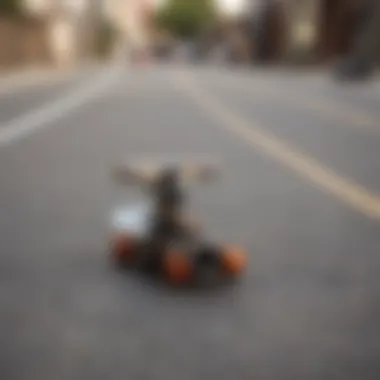

- Align the Tape: Start by placing the grip tape over the deck, making sure it is aligned with the edges. Aim to center it, although a slight overhang on the edges is okay.
- Press Down Smoothly: As you begin to press the tape to the deck, use the palm of your hand or a roller. Work your way from the center towards the edges, which helps to eliminate air bubbles.
- Watch for Bubbles: If you notice any bubbles, use a flat tool—like a credit card—to swipe them toward the edges. This keeps everything smooth.
Getting this part right will influence how your board feels while riding. If it’s not applied correctly, it can lead to slips during a trick and that’s never good news.
Trimming and Finishing Touches
After ensuring the grip tape is applied perfectly, it’s time to move onto the final steps. Trimming may seem trivial, but trust me, it’s the cherry on top:
- Cut the Edges: Take a utility knife and carefully trim around the edges of the skateboard deck. Hold the knife at a slight angle to ensure that you aren’t cutting too deep. A clean cut prevents the tape from peeling away later.
- Smooth Out the Edges: After trimming, run your fingers along the edges to smooth them out and reinforce the adhesive with your body heat.
- Inspect Your Work: Check for any gaps or spots that may need additional attention. A solid grip is all about detail.
Applying grip tape might sound straightforward, but each technique plays a pivotal role in how you skate.
"A clean application transforms your board into a trustworthy partner in every trick."
With the right application techniques, you're setting yourself up for not just improved performance but also a means to express your personal style through grip tape designs. In skateboarding, everything counts, and disregarding the application phase is akin to leaving the house with mismatched shoes—you just don’t do it.
Maintenance and Replacement
In the realm of skateboarding, the condition of one’s gear can significantly influence performance and enjoyment. If your grip tape doesn’t hold up, neither will your tricks. The significance of maintaining and knowing when to replace your Jessup grip tape lies not only in optimizing your performance but also in prolonging the lifespan of your board. Effective maintenance can prevent you from making frequent purchases, keeping your wallet a bit fuller. As they say, a chain is only as strong as its weakest link—your grip tape is often that link between you and your skateboard.
Assessing Wear and Tear
Understanding how to assess the wear and tear on your Jessup tape is crucial. It’s often the case that skaters overlook minor damage, leading to larger issues down the road. Here are some common signs that your grip tape might not be holding up:
- Loss of Texture: If your grip tape feels slick or smooth in areas, it’s an indication that the gritty surface has worn away. This affects your grip and can make executing tricks more difficult.
- Peeling Edges: Take a close look at the edges. If they are starting to peel or lift, it may impact not just your grip but also the integrity of your board.
- Visible Damage: Cracks, holes, or tears are obvious signs you need to reevaluate your grip tape. Not only do they hinder performance, but they can also lead to splinters in your skateboard deck over time.
Regularly checking these aspects can save you from nasty falls or unnecessary replacements. You could take a moment to inspect your grip tape during your regular skate sessions.
"A little upkeep goes a long way—especially when it comes to what keeps you glued to your board."
When to Replace Your Grip Tape
So, how do you know when it’s time to let go and invest in fresh grip tape? The timing can vary, but there are indicators that make it clear:A few key points to consider include:
- Grip Erosion: If you've experienced significant loss in grip, replacing it sooner rather than later pays off. Skateboards can be unpredictable, and you want to maintain as much control as possible.
- Accumulated Dirt and Debris: Sometimes, cleaning may just not do the trick, especially if dirt builds up over extend periods. A good indicator that your tape has had its day is if a simple cleaning doesn’t restore that tackiness.
- Performance Issues: If your tricks aren't feeling right or you're slipping more than you used to, your grip tape could be the culprit. A fresh grip might be exactly what you need to get back in the groove.
Replacing your grip tape isn’t always as dreadful as it sounds; think of it as an investment in your performance and enjoyment.
Cleaning Techniques for Longevity
If you want to extend the life of your grip tape, regular cleaning is essential. Sure, it’s not the most thrilling part of being a skater, but it can make a big difference. Here are some techniques that can help keep your grip fresh:
- Use a Soft Bristle Brush: A soft bristle brush can help remove dirt and debris without damaging the surface. Gently brushing your tape after each session can keep it clean.
- Scotch Tape Method: This technique involves pressing a piece of tape on the dirtied area and quickly pull it away. It lifts some of the gunk without harming your grip.
- Regular Washing: For deep cleaning, use a bucket of water with a mild soap. Submerge the board and use a cloth to scrub the surface gently. Let it dry thoroughly before using it again.
Keeping your grip tape clean will not only enhance your performance but can also prolong its life, making your investment worthwhile. Paying attention to these small details may feel tedious, but in a sport where every ounce of grip counts, it’s worth its weight in gold.
Comparative Analysis
In the world of skateboarding, the comparison of different grip tapes reflects not just personal preference but also the performance characteristics that can make or break a skater's style. The comparative analysis segment is vital, as it enables skaters — from amateur to professional — to weigh options thoroughly and choose effectively not only for performance but also for factors like cost and aesthetics. Understanding the nuances between the Jessup grip and competitor brands plays a critical role in honing one’s skills and enjoying the ride.
Jessup Grip vs. Other Brands
When discussing grip tapes, it is essential to position the Jessup grip against other notable options in the market. Jessup, known for its durability and reliability, often gets matched up with brands like Grizzly and Mob, among others. Each of these brands bring something unique to the table.
Key considerations include:
- Traction Levels: Different brands have varied granule sizes. Jessup typically tends towards a medium grit that provides a good balance between grip and comfort. Comparatively, Mob often features a rougher surface that some skaters swear by for optimal control.
- Longevity: Jessup grip tape tends to hold its integrity longer under wear from various skating styles. However, skaters like the assurance of Grizzly’s thicker material. This thickness, while it might make for a grippier squeeze, can also mean added weight on the skateboard.
- Application and Finish: Jessup grip has straightforward installation; its adhesive is strong yet forgiving enough for repositioning during application. Some users find Grizzly's application a bit tricky. The finish options like color, artwork, and special patterns often play a role in distinctions.
In the grand scheme of skateboarding performance, the right choice often boils down to individual preference and specific skate style. A street skater might prioritize different features than someone who skates bowls or ramps.
User Preferences and Brand Loyalty
The skateboarding community is as much about personal expression as it is about performance. As such, many skaters develop strong loyalties to particular brands based on their experiences and preferences. Brand loyalty can significantly sway purchasing decisions, with several factors influencing this allegiance:
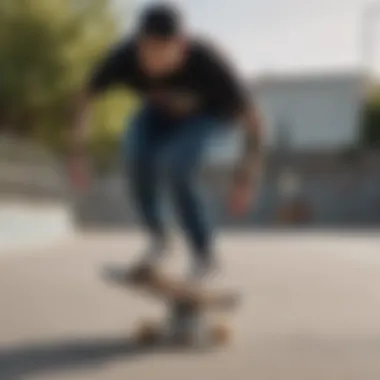

- Community Influence: Sometimes, skaters stick with a brand simply because their peers endorse it. A trick learned while using Jessup might create a sense of loyalty to its product — that experience bonds skaters with the brand.
- Aesthetic Appeal: Often, custom graphics or colors can lure a skater toward a specific grip tape. Jessup has collaborated with various artists and skateboard companies to deliver visually appealing designs, raising the bar in grip tape aesthetics.
“In the realm of skateboarding, harnessing personal style is as crucial as nailing the trick.”
- Performance Trust: Once a skater finds a grip tape that feels just right, they're inclined to stick to it. For many, especially those making long-term investment decisions, the reliability of Jessup enhances trust.
Ultimately, while there are numerous options available, the decision often narrows down to individual skater’s experiences, styles, and the connections they form within the larger community.
Understanding both the comparative factors and the emotional ties skaters develop with their preferred brands equips enthusiasts with actionable insights, fostering a deeper appreciation for their equipment and its impact on their sport.
Market Trends and Innovations
As skateboarding evolves, so does the technology surrounding it, especially when it comes to grip tape. The type of grip tape a skater uses has far-reaching effects on performance and safety. Market trends and innovations play a crucial role in this evolution, reflecting not only consumer demand but also the advancements in materials and design. Skaters, whether seasoned or not, must stay aware of these trends to maximize their riding experience.
Emerging Brands in Grip Technology
Several new players have surfaced in the grip tape market, each vying for the attention of skaters who are always on the lookout for that edge. Brands like Mob Grip and Fallen Grip are starting to dabble in unique textures and grip levels. These emerging brands are not just riding the wave; they’re making waves with innovative products that challenge established standards.
- Mob Grip has earned its reputation through its high-grip surface, but they are constantly experimenting with color designs and enhanced adhesive properties. This continuous innovation speaks volumes about their commitment to both performance and aesthetics.
- Fallen Grip, meanwhile, has made a splash with a focus on eco-friendly materials. Their tackle on grip technology is about meeting the demands of skaters who care about sustainability. By using recycled materials in their grip production processes, they are appealing to a more environmentally-conscious audience.
The market now sees a remarkable diversity that wasn’t there a few years back. Customization has become a keyword in the discussions around grip tape, as these newer companies understand that personality and individuality matter to skaters. As such, they offer options that range from funky graphics to textured patterns, giving each rider the opportunity to express themselves on their board.
"Innovation in grip tape is not just about the product; it is about enhancing the skater's experience, balancing performance with personal style."
Influence of Customization in Grip Choices
Customization has turned grip tape from a mere accessory into an essential component of skateboarding culture. Skaters now desire to showcase their unique identities through their equipment. Custom designs allow skaters to stand out not just for their moves, but for the visual art on their skateboard.
Platforms like Reddit and Facebook have seen an increase in discussions surrounding grip tape design. Skaters share insights about their favorite styles and modifications, leading to an almost communal approach to grip selections. Here are some angles to consider:
- Artistic Expression: Custom grip tape featuring artworks, from graffiti styles to intricate illustrations, allows skaters to transform their boards into a canvas, creating conversations among peers.
- Brand Identity: Many skaters gravitate toward brands that resonate with their personal ethos and aesthetics. The more unique the grip, the stronger the statement.
- Functional Innovations: Custom grip doesn’t just look good; it can also improve function. For instance, grip tapes designed with visual cues for foot placement can help novice skaters balance better.
As these custom trends take root, the traditional views on grip tape are becoming a thing of the past. The focus is shifting from sheer utility to a blend of practicality and personal flair, and this evolving mindset is pushing brands to keep innovating, engaging skaters on multiple levels.
In essence, the interplay between emerging brands and the desire for customization is shaping a dynamic landscape in skateboarding. Skaters have never had more options to choose from, making the right grip tape choice an integral part of their skateboarding journey.
Cultural Impact of Grip Tape
The influence of grip tape within the skateboarding community transcends simple functionality. It acts as a cornerstone of identity, showcasing individuality among skaters while also playing a part in a broader cultural movement. Grip tape, especially the Jessup variety, not only provides traction but has become a canvas for personal expression, connecting deeply with the values of creativity and rebellion often associated with skate culture.
Grip Tape in Skateboarding Identity
For many skaters, the choice of grip tape is a reflection of their personal style and attitude. It serves as an extension of their skateboard, allowing them to express themselves beyond the mere aesthetics of the board itself. Different colors, textures, and designs of grip tape speak volumes. A skater might prefer a traditional black Jessup grip for its minimalist look while another could opt for a brightly colored or patterned variation that highlights their energetic personality. This subtle yet potent choice fosters a deeper connection between skaters and their boards.
Moreover, the act of customizing grip tape has gained traction in skateboarding communities. Skaters often discuss their choices on platforms like Reddit or Facebook, where they share photos of their decks and engage in conversations about the significance of their designs. This ongoing dialogue reinforces a sense of camaraderie and shared identity, binding skaters together through similar experiences and tastes.
Relationship Between Grips and Skate Art
Grip tape has also developed a symbiotic relationship with skate art, allowing for a unique fusion between functionality and creativity. From graffiti-style lettering to intricate designs, grip tape becomes another medium for artists to channel their creativity and make statements. This intertwining is visible in many skateparks where custom grip designs can spark conversations around art and expression.
The visual aspect of grip tape is fortified by how skaters often decorate their boards, creating a vibrant tapestry of personal stories on every deck. It's not uncommon to see a renowned skate artist or brand release special grip tape editions, bridging commercial enterprises with artistic endeavors, ultimately enriching the culture surrounding skateboarding.
In summary, grip tape is far more than a practical choice for skaters; it encapsulates important identity markers and artistic expression. This relationship emphasizes the cultural relevance of the Jessup grip within the community, underscoring its role as an impactful tool for expression, connection, and creativity in a constantly evolving landscape.
The End and Recommendations
In wrapping up our exploration of the Jessup grip, we acknowledge its profound significance in the skateboarding community. This conclusion serves both as a reflection on the importance of grip tape and as a roadmap for your decisions moving forward. A quality grip tape can enhance your riding experience, ensuring you get the best from your skateboard in terms of performance and control. Whether you’re a weekend warrior or a seasoned pro, understanding grip tape's role allows you to make informed choices.
Key Takeaways for Skaters
- Choose Wisely: Not all grip tapes are created equal. Factors like texture, durability, and traction differ among brands and models. Jessup grip tape stands out due to its adherence and longevity, which is critical when you’re out pushing your limits in the skatepark.
- Regular Maintenance is Key: Skaters should routinely inspect their grip tape. Functions like cleaning off debris or even trimming the edges prevent wear and help maintain the traction you rely on. The longevity of your grip can significantly enhance your overall skateboarding experience.
- Personal Preference Matters: Each skater has unique preferences. Some prefer a rough grip for maximum traction, while others might favor a smoother touch for flip tricks. Don’t hesitate to try a few variations to determine what suits your style best.
Future Directions in Grip Technology
Grip tape technology continues to evolve, reflecting developments in materials and design. Expect to see:
- Innovative Materials: The latest creations involve synthetic materials that promise not only enhanced grip but also improved weather resistance. These advancements could be game-changers for outdoor skaters, who face the elements more regularly.
- Eco-Friendly Options: With increasing awareness about environmental impact, brands are looking to develop sustainable grip solutions. Future grip tapes may use biodegradable materials without skimping on quality, catering to the environmentally conscious skater.
- Customization Trends: The opportunity for personalized grip designs is gaining traction within skate culture. Opportunities for custom graphics, textures, or even built-in features could redefine how skaters express themselves through their decks.
Embracing these future trends may provide skaters with enhanced experiences tailored to their individual needs. As the technology advances, those keen on staying at the forefront should keep an eye on emerging products and innovations that could provide a significant edge.





